The term “King Rat” comes from a James Clavell novel which was later made into a Hollywood movie starring George Segal. The story King Rat concerns a group of American and British soldiers being held captive in a Japanese prisoner-of-war camp during World War II. Through clever bargaining and organization, one of the American prisoners, Corporal King, manages to amass a wealth of material goods desperately craved by the other prisoners of war.
As a result, he sits at the top of the prisoner hierarchy and is often able to buy loyalty with a cigarette or fresh egg. The other prisoners simply call him King, for that is what he is inside the prison. When he embarks on a venture to breed rats as food, he earns the title “King Rat,” which somehow seems to fit him.
King Rat enjoys every luxury craved by the other prisoners, yet the fact remains that he is still a prisoner himself. King Rat can only remain at the top of the pecking order so long as everyone remains imprisoned. At the end of the film, when the war is over and the camp is liberated, he no longer has the prison environment he relied on to stay on top. In freedom, he is lost, wondering if he really welcomes the liberation. In the final scene of the movie we see him being driven off in a truck, just another corporal. We sense, however, even if King Rat does not, that he is better off liberated since the fragile fiefdom he had built could have been easily toppled at any time by the Japanese prison keepers. King’s life as a liberated corporal is far more secure than his precarious existence at the top of an oppressed prison population.
The King Rat of cinema was ultimately a sympathetic character. Those whom we might label the “King Rats” of Earth are not so endearing for we will use the term to describe only those individuals who acquire their profits and influence not by breeding rats, but by helping to breed war and suffering for human consumption.
For thousands of years, Earth has had endless successions of “King Rats.” In this chapter, we will look at a particularly interesting group of them: the petty princes of 18th-century Germany. They and their relationship to Brotherhood mysticism provide a fascinating look at a curious element of 18th-century politics—politics which have done much to shape the social, political and economic world we live in today.
Germany became the center of Templar Freemasonry on continental Europe. The Knight degrees took on a unique character in the German states where the degrees were made into a system of Freemasonry called the “Strict Observance.” The “Strict Observance” was so named because every initiate was required to give an oath of strict and unquestioning obedience to those ranking above him within the Order. The vow of obedience extended to a mysterious figure known as the “Unknown Superior,” who was said to be the secret leader of the Strict Observance and who was reportedly residing in Scotland.
Members of the Strict Observance first passed through the Blue Degrees before they were initiated into the higher degrees of “Scottish Master,” “Novice,” “Templar,” and ”Professed Knight.” The “Unknown Superior” went by the title “Knight of the Red Feather.” Although secrecy in the Strict Observance was very strong, several leaks revealed that the Strict Observance was true to the Scottish degrees by agitating against the House of Hanover in favor of the Stuarts.
The Strict Observance spread quickly throughout the German states and became the dominant form of Freemasonry there for decades. It also became influential in other countries such as France, which was the second largest center of Freemasonry in Europe. (Germany was the largest.) In all nations, Strict Observance members pledged obedience to the “Unknown Superior” of Scotland.
According to J. M. Roberts, writing in his book, The Mythology of the Secret Societies:
The Strict Observance evoked suspicion and hostility in France because of its German origins and great excitement was aroused by the implied recognition by the Grand Orient [France’s supreme Masonic body] of the authority of the unknown superiors of the Strict Observance over French freemasons.1
One of the earliest Grand Masters of the Strict Observance was G. C. Marschall. Upon Marschall’s death in 1750, the position was assumed by a German from Saxony: the Baron Von Hund. The Strict Observance degrees had nearly all been created by the beginning of Von Hund’s Grand-Mastership, but Von Hund has been given credit for doing the most to put them into recognizable form. Von -Hund stated that he had been initiated into the Order of the Temple (i.e. the Templar Knights) by Lord Kilmarnock, a prominent nobleman from Scotland. Von Hund also claimed that he had met both the “Unknown Superior” and Charles Edward.
Like Michael Ramsey, Von Hund was on a mission to reestablish the Templar Knights in Europe. Von Hund sought to raise money to repurchase the lands which had been seized from the Templars centuries earlier. Although Von Hund had many successes, he was branded a fraud by his enemies and he eventually fell into disgrace.
The Strict Observance gained a strong following among the German royal families (although some opposed it and remained loyal to the English Masonic system). This is a puzzle. Some royal families involved in the Strict Observance were politically allied to Hanover. Why would they participate in a form of Freemasonry which secretly opposed the English House of Hanover?
In some cases, it appears that the royal members had joined the Strict Observance after it ceased to be virulently pro-Stuart. Certainly the Stuart cause was waning by the 1770’s when some of those German princes emerged as Strict Observance leaders. On the other hand, there is another important factor to be considered:
The woes of England caused by the Stuart rebellion and by other conflicts were a source of immense profit to those German principalities, including to Hannover! That same small clique of German royal dynasties which had been marrying into foreign royal families and then overthrowing them, made big money from the conflicts which they helped to create—conflicts which were also being stirred up by the Brotherhood network.
To better understand this situation, we must briefly digress and review the history of the Teutonic Knights after they were defeated in the Crusades.
When the Crusades ended, the Teutonic Knights, like the Templar and Hospitaler Knights, found work elsewhere. In 1211, while under the leadership of Grand Master Hermannvon Salza, the Teutonic Knights were invited to Hungary to aid a struggle going on there. For their services, they were awarded the district of Burzenland in Transylvania, which was then under Hungarian rule. The Knights outlived their welcome, however, and were expelled because they demanded too much land. After their ouster from Transylvania, the Knights were invited by Conrad, Polish Prince of Masovia, to help fight heathen Slavs in Prussia. The Knights were again rewarded with land. This time they received large sections of Prussia.
The Knights gained another benefactor: German Emperor Frederick II—the man who made the ten-year peace treaty we discussed in Chapter 15. Although Frederick had acted as a man of peace, he was unfortunately also associated with this organization of war. In 1226, Frederick empowered the Knights to become overlords of Prussia. Frederick awarded to Grand Master von Salza the status of a prince of the German Holy Roman Empire. Frederick was also responsible for a reorganization of the Order.
The Teutonic Knights were thoroughly entrenched in Prussia by the year 1229. They built solid fortresses and imposed Christianity on the native Prussian populace with an energetic military campaign. By 1234, the Knights were politically autonomous and served under no authority except the Pope. The Knights surrendered their extensive Prussian holdings to the Pope in name and received them back as fiefs. In reality, the Teutonic Knights were the true rulers of Prussia, not the Pope.
With Papal support, the ranks of the Teutonic Knights ballooned rapidly. Many Germans traveled to Prussia to enter the new and potentially lucrative theatre of war.
This migration eventually brought about the complete ”Germanization” of Prussia. Commerce and industry eventually replaced armed conflict and Prussia became a major commercial center. By the early 1300’s, the dominion of the Teutonic Knights extended over most of the southern and southeastern coastline of the Baltic Sea. The Teutonic Knights had two centuries in which to leave their indelible mark on central and western Europe. Before losing power, the Knights had established the militant character of Prussia that would define that region for centuries to follow.
By the early 1500’s the fate of the Teutonic Knights had worsened. They were driven out of West Prussia by Poland and were forced to rule East Prussia as a Polish fief. By 1618, Prussia fell completely under the rule of the Hohenzollern dynasty. This effectively marked the end of autonomous Teutonic Knight rule.
Despite continuing friction between the Knights and the Hohenzollerns over control of Prussia, the Hohenzollerns kept significant elements of the Knight organization alive. At least one Hohenzollern, Albert of Brandenburg-Anspach, had been a Grand Master of the Order around 1511. Hohenzollern Prussia adopted the colors of the Teutonic cloaks (black and white) as the official hues of the land. The two-headed Teutonic bird became Prussia’s national symbol.
Like the other knightly organizations of the Crusades, the Teutonic Knights were eventually turned into a secret fraternal society, this time under the sponsorship of the royal Hapsburg family of Austria. The Teutonic Knights still survive in that form today.
Under the rule of the Hohenzollerns, the power and influence of Prussia grew. Prussia became a formidable player in the tangled political arena of Europe. By the eighteenth century, the Hohenzollerns had also become extensively intertwined with their German royal neighbors through marriage. For example, history’s most famous Hohenzollern, Frederick II (better known as “Frederick the Great”), had been set up by his father in 1733 to marry Elizabeth Christina of the northwestern German principality of Brunswick. (In 1569, the Brunswick dynasty had founded the Brunswick-Luneburg family line which later became the Hannover family.) Frederick’s mother was Sophia Dorothea, sister of Hanoverian King George II. Generations earlier, Frederick the Great’s great grandfather had married Henrietta, daughter of the Prince of Orange.
Political marriages, because they were usually loveless, were often unsatisfactory to those who were wed. This proved true in the joining of Frederick the Great to Elizabeth Christina of Brunswick. Frederick had wanted to marry one of the Hanoverians, but his father’s stern will prevailed. Despite this unhappy arrangement, Frederick still had amicable ties to others in the Brunswick family. It was in Brunswick that Frederick, not yet the King of Prussia, was secretly initiated into Freemasonry on August 14, 1738 against his father’s wishes. The initiation had been authorized by the Lodge of Hamburg in Hannover. The Lodge practiced the Blue Degrees of English Freemasonry.
Two years after his initiation, Frederick II became the king of Prussia. He then publicly revealed his Masonic membership and initiated others into the Order.* At Frederick’s command, a Grand Lodge was established in Berlin called Lodge of Three Globes. Its first meeting was held on September 13, 1740. This Lodge began as an English system lodge and it had the authority to grant charters.
*In 1740, Frederick initiated several other important German nobles into Freemasonry: his brother, Prince William; the Margrave (Prince) Charles of Brandenburg (whose family was also married into the House of Hanover through Caroline of Brandenburg as wife to King George II); and Frederick William, the Duke of Holstein.
How long Frederick remained active in Freemasonry is still debated today. Some historians believe that he ceased his Masonic activities in 1744 when the demands of war occupied his full attention. His general cynicism later in life eventually extended to Freemasonry. Nevertheless, Frederick’s name continued to appear as the authority for Masonic charters even after he was reportedly inactive. It is uncertain whether Frederick merely lent his name to the granting of charters or was personally involved in the process.
How long Frederick remained active in Freemasonry is still debated today. Some historians believe that he ceased his Masonic activities in 1744 when the demands of war occupied his full attention. His general cynicism later in life eventually extended to Freemasonry. Nevertheless, Frederick’s name continued to appear as the authority for Masonic charters even after he was reportedly inactive. It is uncertain whether Frederick merely lent his name to the granting of charters or was personally involved in the process.
Within about a decade of Frederick’s Masonic initiation, the Strict Observance and its Scottish degrees were in the process of almost completely taking over German Masonry. Frederick’s Lodge of Three Globes became decidedly “Strict Observance” when its new statutes were adopted on November 20, 1764. On January 1, 1766, Baron VonHund, Grand Master of the Strict Observance, constituted the Three Globes as a Scots or Directoral Lodge empowered to warrant other Strict Observance Lodges. All lodges already warranted by the Three Globes except one (the Royal York Lodge) went over to the Strict Observance (Scottish) system.
Whatever Frederick’s masonic involvement may or may not have been, he and his Prussian kingdom profited from the conflicts of England that Scottish Masonry had been contributing to.
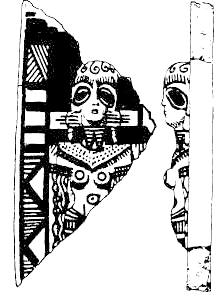
An ancient Mesopotamian depiction of one of their female extraterrestrial “Gods.”
The “Gods” were very humanlike with male and female bodies. The eyewear, form-fitted clothing, and body apparatus on the above “God” are strongly reminiscent of modern aviator’s goggles, airtight suit, and modern gadgetry.
(Reproduced by permission from The Twelfth Planet, by Zecharia Sitchin.)
(Reproduced by permission from The Twelfth Planet, by Zecharia Sitchin.)
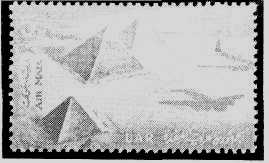
The Great Pyramid is also pointed precisely along the four compass directions. This postage stamp issued by Egypt in 1959 shows an airplane flying in direct alignment with the Great Pyramid, as though to suggest that the pilot is using the pyramid to guide the airplane.
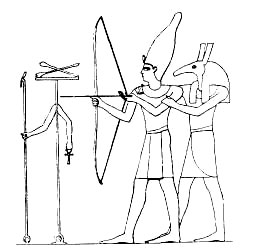
Egypt’s Custodial “Gods” were said to participate in the up-bringing of the pharaohs. In this Egyptian illustration we see Pharaoh Thutmose III being given an archery lesson by one of his “Gods.” Thutmose became famous for his military exploits.
This illustration suggests that Custodians had a role in training humans to be warlike.
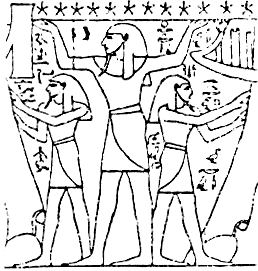
The Custodial "gods" of ancient Egypt were very often depicted wearing aprons.
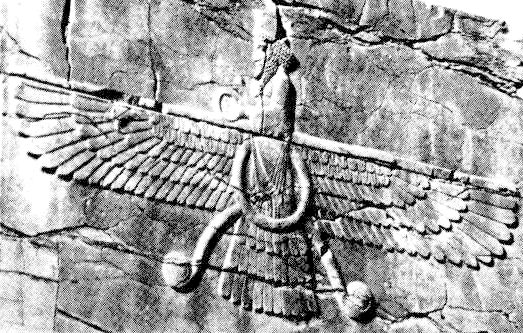
The Zoroastrian “God, “ Ahura Mazda, was depicted in ancient Persia as a humanlike creature who flew in a circular object. The object is depicted with stylized wings and bird’s tail to indicate that it flies. It also had bird’s feet that look like landing struts.
Depictions such as these were not meant to be literal images of the “God, “but were meant to portray the “God ” in such a way so as to reveal its attributes. Zoroaster’s “God ” had the attributes of being humanlike and flying about in a circular craft.
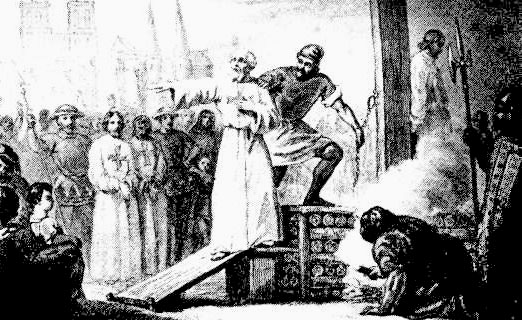
Grand Master of the Templar Knights, Jacques de Molay, is led to a stake where he will be burned. Three other Templar Knights also await execution. The burning took place in Paris; in the background one can see the Cathedral of Notre Dame.
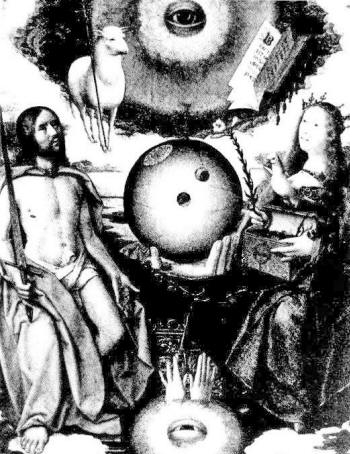
Christianity has been closely associated with Brotherhood mysticism since the lifetime of Jesus. This painting by Jan Provost (ca. 1465-1529) is entitled, “A Christian Allegory.” It features Christian symbols—among them the “All-Seeing Eye” of God and the lamb. Both of these symbols were used by the Brotherhood long before the advent of Christianity.
The “All-Seeing Eye” of God was derived from the “Eye of Horus” symbol used in ancient Egypt. Horus was one of Egypt’s Custodial “Gods.“ The lamb was already symbolically important during the reign of Melchizedek centuries before the birth of Jesus. It was Melchizedek‘s branch of the Brotherhood that reportedly first began to use lambskin for its ceremonial aprons.
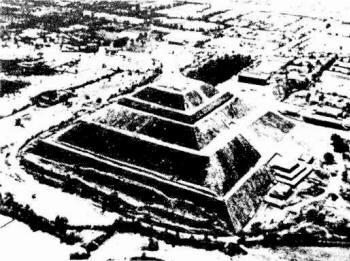
The extraordinary similarities between the ancient civilizations of Egypt and America are too striking to be coincidence. Above is the ancient Mexican Pyramid of the Sun, which resembles the first step pyramid of Egypt.
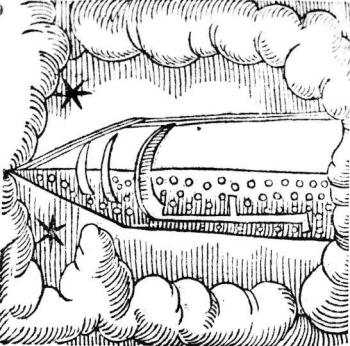
Centuries ago, almost any unusual flying object was called a “comet.” The above is an illustration published in 1557 of a “comet” observed in 1479 in Arabia. The comet was described as looking like a sharply pointed wooden beam.
.
The artist’s concept, which was based on eyewitness testimony, looks like a rocketship with numerous port holes. Many other ancient reports of “comets” may well have been of similar objects.
(Reproduced from 'A Chronicle of Prodigies and Portents'... by Conrad Lycosthenes.)
(Reproduced from 'A Chronicle of Prodigies and Portents'... by Conrad Lycosthenes.)
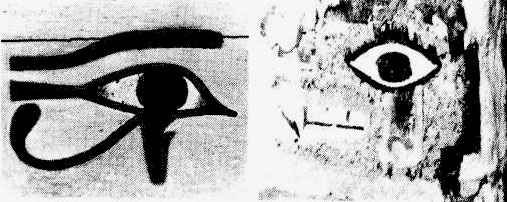
ABOVE LEFT AND RIGHT: The similarities between ancient Old and New World civilizations are also seen in some of the symbols used by both. Above left is the Eye of Horus symbol found in ancient Egypt. Above right is a similar eye found on an ancient American artifact.
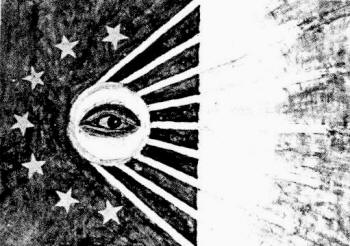
ABOVE AND BELOW: Many proposed designs were submitted for a flag for the new Confederacy. These two proposals, which are preserved today in the United States National Archives, prominently feature the Brotherhood’s symbol of the All-Seeing Eye. The Confederate leaders eventually opted for a simple cross bars and stars design.
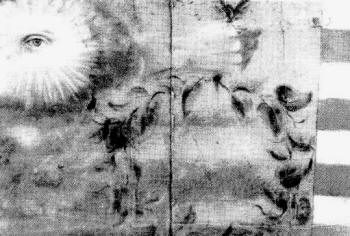
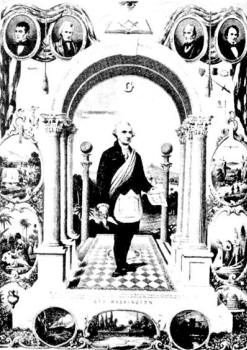
Depiction of George Washington wearing his Masonic regalia.
Despite his domestic liberalism and professed anti-Machiavellian beliefs, Frederick proved by his actions to be as warlike and as shrewdly manipulative in the complex web of European politics as any man of his day. His goal was the militaristic expansion of the Prussian kingdom. He was not above aiding insurrection and being fickle in his alliances to achieve his goal. In the 1740’s, Frederick had a political alliance with France. France was actively supporting the Jacobites against the Hanoverians and rumors circulated in London that Frederick was helping the Jacobites prepare for their big invasion of England in 1745.
Frederick afterwards shifted his alliance back to England and continued to profit from England’s woes. He not only gained territory, but money as well. Sharing in Frederick’s monetary profits were other German principalities, including Hannover itself. They all made their money by renting German soldiers to England at exorbitant prices. Hannover had already been engaged in this enterprise for decades.
The rental of German mercenaries to England was perhaps one of the great “scams” of European history: a small clique of German families overthrew the English throne and placed one of their own upon it. They then used their influence to militarize England and to involve it in wars. By doing so, they could milk the British treasury by renting expensive soldiers to England to fight in the wars they helped to create! Even if the Hanoverians were unseated in England, they would go home to German Hannover with a handsome profit made from the wars to unseat them.
This may be one key to the puzzle of why some members of this German clique supported Scottish Templar Freemasonry and later took on leadership positions within it.
England rented German mercenaries through the signing of “subsidy treaties,” which were really business contracts. England began entering into subsidy treaties almost immediately after the German takeover of their country by the House of Orange in 1688. As we recall, one of the first things that William and Mary did after taking the English throne was to launch England into war.
The German mercenaries were a constant burden to England. One early mention of them is found in the correspondence of the Duke of Marlborough.*
* Letters written by the Duke of Marlborough are translated here into modern English.
Marlborough was an English leader fighting on the European continent against France during the War of Spanish Succession (1701-1714).**
**Wars of “succession” were wars sparked by disputes over who should succeed to a royal throne. The major European powers often got involved in these frays and turned them into large-scale conflicts which could drag on for years.
Hannover was renting troops to England at that time—years before Hannover took the British throne. On May 15, 1702, Marlborough discussed the need to pay the Hannoverian troops so that they would fight:
If we have the Hanover troops, I am afraid there must be one hundred thousand crowns given them before they will march, so that it would be very much for the Service if that money were ready in Holland at my coming.2
Four days later, 22,600 pounds were allocated by the English government to pay the mercenaries.
Prussia and Hesse were also supplying mercenaries to Britain during that war. Marlborough’s woes in getting them paid continued. Writing from the Hague on March 26, 1703, he lamented:
Now that I am come here [the Hague] I find that the Prussians, Hessians, nor Hanoverians have not received any of their extraordinaries [fees] .. .3
England’s next major European war was the War of Austrian Succession (1740-1748). Frederick the Great was allied with France against England this time. This did not stop other German principalities from continuing their business relationship with England, especially Hannoverand Hesse. Although Hannover now sat on the British throne, it was not about to cease its profitable enterprise. If anything, Hannover’s British reign gave that German principality greater leverage to drive even harder bargains with England for Hannoverian mercenaries.
A letter written on December 9, 1742 by Horace Walpole, Britain’s former Prime Minister, discussed the enormous fee England was asked to pay for renting 16,000 Hannoverian troops:
. . . there is a most bold pamphlet come out... which affirms that in every treaty made since the accession [to the British throne] of this family [Hanover], England has been sacrificed to the interests of Hanover. . .4
The pamphlet mentioned by Walpole contained these amusing words:
Great Britain hath been hitherto strong and vi[g]orous enough to bear up Hanover on its shoulders, and though wasted and wearied out with the continual fatigue, she is still goaded on . . . For the interests of this island [England] must, for this once, prevail, or we must submit to the ignominy of becoming only a money-province to that electorate [Hannover].5
In the end, opposition to the subsidy treaties failed. England truly became Hannover’s “money-province.”
Lamented Walpole:
We have every now and then motions for disbanding Hessians and Hanoverians, alias mercenaries; but they come to nothing.6
The subsidy treaties were indeed lucrative. For example, in the contract year beginning December 26, 1743,the British House granted 393,733 pounds for 16,268 Hannoverian troops. This may not seem like much until we realize that the value of the pound was very much higher than it is today. To raise some of this money, the Parliament went as far as to authorize a lottery.
At the same time that England was fighting the War of Austrian Succession, it was also fighting the Jacobites. More German troops were needed on that front.
At the same time that England was fighting the War of Austrian Succession, it was also fighting the Jacobites. More German troops were needed on that front.
On September 12, 1745, Charles Edward of the Stuart family led his famous invasion of England by way of Scotland. “Bonnie Prince Charlie,” as Charles Edward was called, captured Edinburgh on September 17 and was approaching England with the intent of taking London. That meant more money for Hesse. On December 20, 1745, Hanoverian King George II announced that he had sent for 6,000 Hessian troops to fight in Scotland against Charles Edward.
King George presented Parliament with a bill for the Hessian troops. It was approved. The Hessians landed on February 8 of the following year. Meanwhile, back on the European front, England hired more soldiers from Holland, Austria, Hannover, and Hesse to pursue England’s “interests” there. The bills were staggering.
The war on the Continent finally ended. It was not long, of course, before the rulers of Europe were involved in another one. This time it was the Seven Years War (1756-1763)— one of the largest armed conflicts in European history up until that time.*
* The Seven Years War was actually an expansion of the French and Indian War being fought in North America between England and France. The expansion of the war into Europe had been triggered by Frederick the Great himself when he invaded Saxony.
Frederick of Prussia had switched his allegiance back again to England, and the two nations (England and Prussia) were pitted against France, Austria, Russia, Sweden, Saxony, Spain, and the Kingdom of Two Sicilies. Frederick did not ally himself to England this time out of fickle love for Britain. England was paying him. By the Treaty of Westminster effective April 1758, Frederick received a substantial subsidy from the English treasury to continue his fighting, much of it to defend his own interests! The treaty ran from April to April and was renewable annually.
During the Seven Years War, England also paid out money to help Hannover defend its own German interests. France had attacked Hannover, Hesse, and Brunswick. Some of the subsidy money paid to Hannover and Hesse was used by those principalities to defend their own borders. The treaty with Hesse, signed on June 18, 1755 (shortly before the Seven Years War erupted) was especially generous. In addition to “levy money” (money used to gather an army together) and “remount money” (money used to acquire fresh horses), Hesse was granted a yearly subsidy of 36,000 Pounds when its troops were under German pay, and double that when they entered British pay. An additional 36,000Pounds went directly to the coffers of the Landgrave of Hesse.
Many English Lords did not feel that German troops were worth the money. While discussing a possible French invasion of England, Walpole joked,
“if the French do come, we shall at least have something for all the money we have laid out on Hanoverians and Hessians!”7
William Pitt, another influential English statesman, added these amusing words to the debate:
The troops of Hanover, whom we are now expected to pay, marched into the Low Countries, where they still remain. They marched to the place most distant from the enemy, least in danger of an attack, and most strongly fortified had an attack been designed. They have, therefore, no other claim to be paid than that they left their own country for a place of greater security. I shall not, therefore, be surprised, after such another glorious campaign... to be told that the money of this nation cannot be more properly employed than in hiring Hanoverians to eat and sleep.8
The German principality to profit most from the soldiers-for-hire business was Hesse.
In taking a quick look at the history of Hesse, we find that after Philip the Magnanimous died in 1567,Hesse was divided between Philip’s four sons into four main provinces: Hesse-Kassel (often spelled Hesse-Cassel), Hesse-Darmstadt, Hesse-Rheinfels, and Hesse-Marburg. The most important and powerful of these four Hessian regions became Hesse-Kassel, into which Hesse-Rheinfels and Hesse-Marburg would later be reabsorbed.
Renting mercenaries to England became the Hessian royal family’s most lucrative enterprise. Although Hesse itself was scarred during some of the European conflicts, the Hessian dynasty built an immense fortune from the soldier business. In fact, Landgrave Frederick II of Hesse-Kassel (not to be confused with Frederick II of Prussia or with the German emperor Frederick II of the Crusade era) made Hesse-Kassel the richest principality in Europe by renting out mercenaries to England during Britain’s next great struggle: the War for American Independence, also known as the American Revolution. Also benefiting from the American Revolution was the royal House of Brunswick. Its head, Charles I, rented soldiers to England at a very handsome price to help fight the rebelling colonists.
As we can see, Hesse, Hannover and a few other German states profited handsomely from the conflicts which had beset England. The problems of Britain gave them the opportunity to plunder the British treasury at the expense of the English people. This had the additional effect of pushing England into ever-deepening debt to the new bankers with their inflatable paper money.
The populace of Germany also suffered. Most of the mercenaries rented to England were young men involuntarily conscripted and forced to fight where their leaders sent them. Many were maimed and killed so that their rulers could live in greater luxury. The wealth and influence of a small clique of German dynasties had been built upon the blood of the young.
Lurking behind these activities we continue to find the presence of the Brotherhood network. As the years progressed, members of the royal families of Hesse and Brunswick emerged as leaders of the Strict Observance. In 1772, for example, at a Masonic congress in Kohlo, Duke Charles William Ferdinand of Brunswick was chosen to succeed Von Hund as Grand Master of the Strict Observance.*
* With the election of Duke Ferdinand, the Strict Observance underwent several changes. The Strict Observance was informally called the “United Lodges.” Another congress was held ten years later in 1782 in Wilhelmsbad (a city near Hanau in Hesse-Kassel). There the name “Strict Observance” was dropped altogether and the Order was thereafter called the “Beneficent Knights of the Holy City.” The Wilhelmsbad congress officially abandoned the story that the Templar Knights were the original creators of Freemasonry. However, the Knight degrees were retained, as was the idea of leadership by an “Unknown Superior.”
Several years after his election to the Grand Master position, Duke Ferdinand succeeded Charles I as the ruler of Brunswick and inherited the money from Brunswick’s rental of mercenaries.
Sharing leadership duties in the Strict Observance with the Duke of Brunswick was Prince Karl of Hesse, son of Frederick II of Hesse-Kassel. According to Jacob Katz in his book, Jews and Freemasons in Europe, 1723-1939, Prince Karl was later “accepted as the head of all German Freemasons.”9
Karl’s brother, William IX, who later inherited the principality and immense fortune of Hesse-Kassel from their father, was also a Freemason. William IX had provided mercenaries to England when he earlier ruled Hesse-Hanau.
How important a role did the Brotherhood itself really play in manipulating these affairs?
To determine if there truly was active Brotherhood involvement of a Machiavellian nature, it would help to discover if there was any single Brotherhood agent who participated first in one faction and then in another. We would require a Brotherhood agent traveling in all circles: from the Jacobites to the electors of Hesse, from the King of France to Prussia.
Interestingly, history records just such an individual. We would not normally learn of such an agent because of the secrecy surrounding Brotherhood activity. This particular person, however, by virtue of his flamboyant personality, his remarkable artistic talents, and his flair for drama, had attracted so much attention to himself that his activities and travels were noted and recorded for posterity by many of the people around him.
Deified by some and declared a charlatan by others, this flamboyant agent of the Brotherhood was best known by a false appellation: the Count of St. Germain.

No comments:
Post a Comment